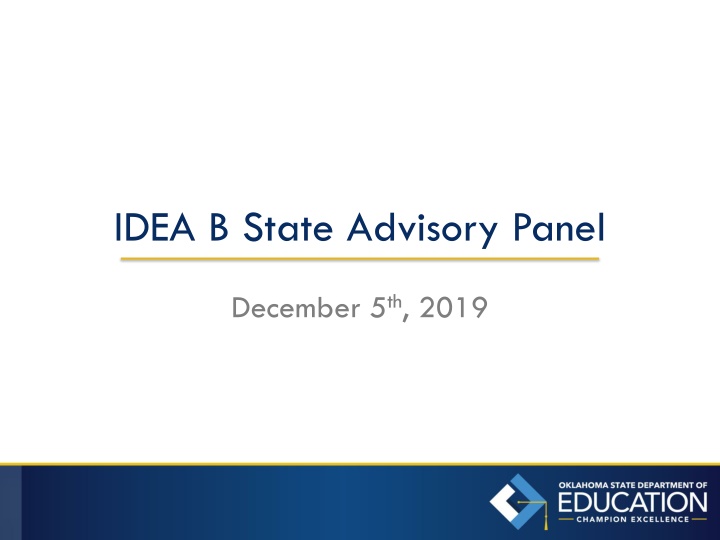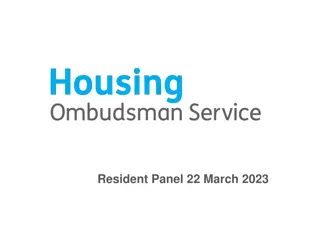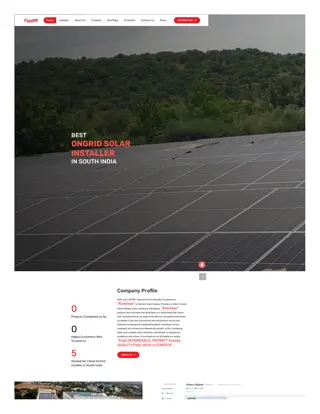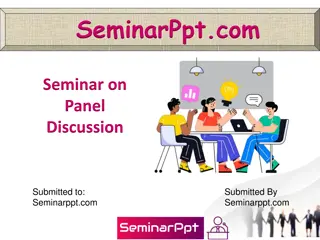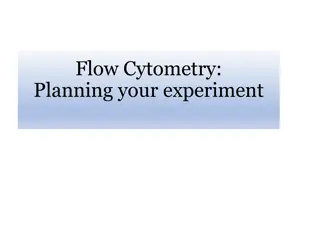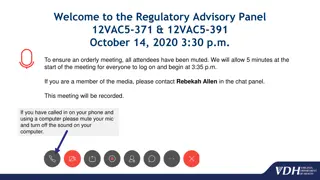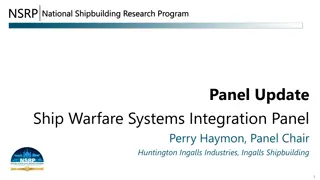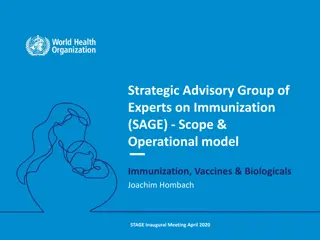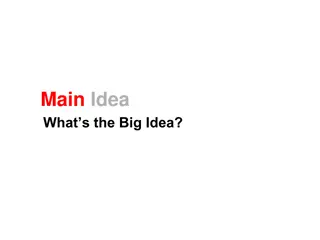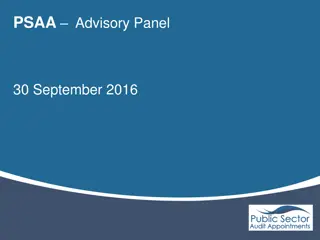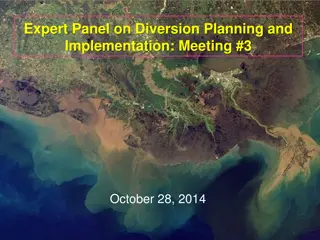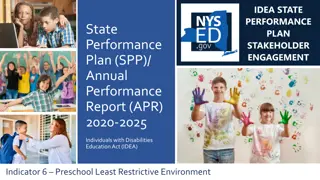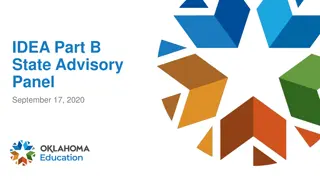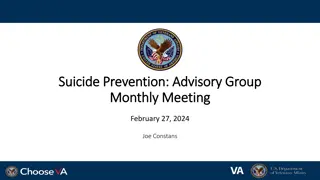IDEA.B State Advisory Panel Meeting Overview
The IDEA.B State Advisory Panel meeting held on December 5th, 2019, covered various topics including updates from the Oklahoma State Department of Education, panel goals for 2019-2020, determinations, rules, caseload policy, and target-setting for the Annual Performance Report. Discussions revolved around teacher retention and recruitment, monitoring and determinations, graduation data, and setting targets for indicators. The meeting provided valuable insights and updates for stakeholders involved in special education in Oklahoma.
Download Presentation

Please find below an Image/Link to download the presentation.
The content on the website is provided AS IS for your information and personal use only. It may not be sold, licensed, or shared on other websites without obtaining consent from the author.If you encounter any issues during the download, it is possible that the publisher has removed the file from their server.
You are allowed to download the files provided on this website for personal or commercial use, subject to the condition that they are used lawfully. All files are the property of their respective owners.
The content on the website is provided AS IS for your information and personal use only. It may not be sold, licensed, or shared on other websites without obtaining consent from the author.
E N D
Presentation Transcript
IDEA B State Advisory Panel December 5th, 2019
Agenda 1:00 2:15: Welcome - Bonnie McBride OSDE Updates Todd Loftin, Christa Knight, Ginger Elliott- Teague 2:15 2:30: Break 2:30 3:45 Panel Goals for 19-20 Bonnie McBride Teacher Retention and Recruitment Bonnie McBride 3:45 4:00 Public Comment/Wrap-Up 4:00: Adjourn
OSDE Updates Monitoring and Determinations Seclusion/Restraint Rule Shortened Day Rule Certification Caseload Policy APR Indicator Targets SSIP Planning
MONITORING AND DETERMINATIONS
Determinations - 1 2019 Meets Requirements:248 Needs Assistance: Needs Intervention: 53 Needs Substantial Intervention: 2 2018 Meets Requirements:446 Needs Assistance: Needs Intervention: 13 242 84
Determinations - 2 2017 Meets Requirements:272 Needs Assistance: Needs Intervention: 17 2016 Meets Requirements:498 Needs Assistance: Needs Intervention: 7 252 32
Rules See Handout
Target-setting ANNUAL PERFORMANCE REPORT
Overview OSEP has extended the current SPP/APR* for another year States must set targets for relevant indicators for FFY 2019 Oklahoma s preference: Maintain FFY 2018 targets New SPP/APR expectations to be issued in 2020 for State discussion & target setting
Indicator 1: Graduation Historical Data Baseline FFY Target >= Data 2011 2013 85.00% 78.49% 84.50% 2014 87.00% 77.23% 2015 87.00% 75.55% 2016 87.00% 74.44% 2017 87.00% 76.97% Targets FFY 2018 2019 Target >= 87.00% 87.00%
Indicator 2: Drop Out Historical Data Baseline FFY Target >= Data 2011 2013 19.40% 19.40% 20.70% 2014 19.40% 20.30% 2015 18.00% 19.75% 2016 17.00% 16.60% 2017 16.00% 14.25% Targets FFY 2018 2019 Target >= 15.00% 15.00%
Indicator 3B: Reading Participation Historical Data Baseline FFY Target >= Data 2005 2013 95.00% 93.19% 98.60% 2014 95.00% 98.68% 2015 95.00% 98.93% 2016 95.00% 98.69% 2017 95.00% 97.97% Targets FFY 2018 2019 Target >= 95.00% 95.00%
Indicator 3B: Math Participation Historical Data Baseline FFY Target >= Data 2005 2013 95.00% 93.27% 98.70% 2014 95.00% 98.71% 2015 95.00% 98.68% 2016 95.00% 98.51% 2017 95.00% 97.86% Targets FFY 2018 2019 Target >= 95.00% 95.00%
Indicator 3C: Reading Proficiency Historical Data Baseline FFY Target >= Data 2016 2013 53.00% 53.00% 14.03% 2014 54.00% 33.03% 2015 55.00% 33.02% 2016 14.03% 14.03% 2017 14.25% 12.60% Targets FFY 2018 2019 Target >= 14.50% 14.50%
Indicator 3C: Math Proficiency Historical Data Baseline FFY Target >= Data 2016 2013 58.80% 58.86% 14.75% 2014 60.00% 35.84% 2015 61.70% 35.39% 2016 14.75% 14.75% 2017 15.00% 13.43% Targets FFY 2018 2019 Target >= 15.25% 15.25%
Indicator 4A: Discrepant Districts, Suspensions >10 Days Historical Data Baseline FFY Target >= Data 2005 2013 7.10% 6.81% 7.59% 2014 7.10% 8.42% 2015 7.00% 1.45% 2016 6.60% 14.71% 2017 6.30% 14.71% Targets FFY 2018 2019 Target >= 6.00% 6.00%
Indicator 4B: Suspension/Expulsion Historical Data Baseline FFY Target >= Data 2016 2013 0% 0% 0% 2014 0% 0% 2015 0% 0% 2016 0% 0% 2017 0% 0% Targets FFY 2018 2019 Note: This is a compliance indicator. The target is set by OSEP. Target >= 0% 0%
Indicator 5A: LRE Gen Ed >80% Historical Data Baseline FFY Target >= Data 2005 2013 64.68% 64.68% 49.27% 2014 65.00% 65.89% 2015 65.50% 65.50% 2016 65.50% 70.87% 2017 66.00% 67.98% Targets FFY 2018 2019 Target >= 66.00% 66.00%
Indicator 5B: LRE Gen Ed <40% Historical Data Baseline FFY Target >= Data 2005 2013 9.84% 9.51% 9.70% 2014 9.84% 9.53% 2015 9.50% 9.44% 2016 9.50% 8.26% 2017 9.25% 9.19% Targets FFY 2018 2019 Target >= 9.25% 9.25%
Indicator 5C: LRE Separate Historical Data Baseline FFY Target >= Data 2005 2013 1.85% 1.30% 1.84% 2014 1.85% 1.31% 2015 1.85% 1.23% 2016 1.85% 0.79% 2017 1.85% 0.64% Targets FFY 2018 2019 Target >= 1.83% 1.83%
Indicator 6A: EC Env. Regular Ed Historical Data Baseline FFY Target >= Data 2011 2013 40.66% 40.66% 39.29% 2014 41.25% 44.01% 2015 42.00% 48.54% 2016 42.50% 34.07% 2017 43.00% 32.54% Targets FFY 2018 2019 Target >= 43.75% 43.75%
Indicator 6B: EC Env. Separate Historical Data Baseline FFY Target >= Data 2011 2013 18.40% 16.16% 18.60% 2014 18.40% 13.91% 2015 17.75% 13.01% 2016 17.00% 15.03% 2017 16.50% 16.75% Targets FFY 2018 2019 Target >= 16.00% 16.00%
Indicator 7 A1: Growth Social-Emotional Historical Data Baseline FFY Target >= Data 2008 2013 89.30% 92.63% 93.30% 2014 89.50% 93.92% 2015 89.75% 93.10% 2016 90.00% 92.95% 2017 90.50% 93.43% Targets FFY 2018 2019 Target >= 93.40% 93.40%
Indicator 7 A2: Peer-level Social-Emotional Historical Data Baseline FFY Target >= Data 2008 2013 58.00% 55.53% 54.50% 2014 58.00% 61.78% 2015 58.25% 61.36% 2016 58.50% 59.91% 2017 58.75% 63.73% Targets FFY 2018 2019 Target >= 59.00% 59.00%
Indicator 7 B1: Growth Knowledge-Skills Historical Data Baseline FFY Target >= Data 2008 2013 88.80% 92.02% 92.80% 2014 89.00% 92.97% 2015 89.25% 92.25% 2016 89.50% 92.57% 2017 89.75% 91.65% Targets FFY 2018 2019 Target >= 92.90% 92.90%
Indicator 7 B2: Peer-level Knowledge-Skills Historical Data Baseline FFY Target >= Data 2008 2013 57.30% 54.50% 55.00% 2014 57.30% 61.25% 2015 57.30% 58.32% 2016 57.30% 58.22% 2017 57.30% 60.11% Targets FFY 2018 2019 Target >= 58.30% 58.30%
Indicator 7 C1: Growth Behavior-Needs Historical Data Baseline FFY Target >= Data 2008 2013 90.80% 92.90% 92.90% 2014 91.00% 94.23% 2015 91.25% 93.27% 2016 91.50% 92.78% 2017 91.75% 93.86% Targets FFY 2018 2019 Target >= 93.00% 93.00%
Indicator 7 C2: Peer-level Behavior-Needs Historical Data Baseline FFY Target >= Data 2008 2013 72.00% 69.84% 67.70% 2014 72.00% 76.09% 2015 72.00% 72.66% 2016 72.00% 73.49% 2017 72.00% 76.27% Targets FFY 2018 2019 Target >= 73.00% 73.00%
Indicator 8: Parent Involvement Historical Data Baseline FFY Target >= Data 2005 2013 87.00% 90.10% 82.11% 2014 88.25% 88.89% 2015 89.50% 90.14% 2016 90.50% 97.24% 2017 91.75% 98.38% Targets FFY 2018 2019 Target >= 93.00% 93.00%
Indicator 9: Disproportionate Representation in SPED Historical Data Baseline FFY Target >= Data 2005 2013 0% 0% 0% 2014 0% 0% 2015 0% 0% 2016 0% 0.20% 2017 0% 0% Targets FFY 2018 2019 Note: This is a compliance indicator. The target is set by OSEP. Target >= 0% 0%
Indicator 10: Disproportionate Representation in Specific Disability Categories Historical Data Baseline FFY Target >= Data 2016 2013 0% 0% 0% 2014 0% 0% 2015 0% 0% 2016 0% 0% 2017 0% 0% Targets FFY 2018 2019 Note: This is a compliance indicator. The target is set by OSEP. Target >= 0% 0%
Indicator 11: Child Find Historical Data Baseline FFY Target >= Data 2005 2013 100.00% 95.84% 90.89% 2014 100.00% 95.32% 2015 100.00% 96.69% 2016 100.00% 98.09% 2017 100.00% 97.65% Targets FFY 2018 2019 Note: This is a compliance indicator. The target is set by OSEP. Target >= 100.00% 100.00%
Indicator 12: Early Childhood Transition Historical Data Baseline FFY Target >= Data 2005 2013 100.00% 92.40% 86.72% 2014 100.00% 98.84% 2015 100.00% 99.06% 2016 100.00% 98.52% 2017 100.00% 97.65% Targets FFY 2018 2019 Note: This is a compliance indicator. The target is set by OSEP. Target >= 100.00% 100.00%
Indicator 13: Secondary Transition Historical Data Baseline FFY Target >= Data 2009 2013 100.00% 95.47% 95.21% 2014 100.00% 97.72% 2015 100.00% 99.72% 2016 100.00% 99.57% 2017 100.00% 99.86% Targets FFY 2018 2019 Note: This is a compliance indicator. The target is set by OSEP. Target >= 100.00% 100.00%
Indicator 14A: Post-School Outcomes Historical Data Baseline FFY Target >= Data 2009 2013 31.90% 15.59% 31.42% 2014 32.00% 26.53% 2015 32.00% 24.47% 2016 32.00% 22.32% 2017 32.00% 24.56% Targets FFY 2018 2019 Target >= 32.75% 32.75%
Indicator 14B: Post-School Outcomes Historical Data Baseline FFY Target >= Data 2009 2013 46.90% 48.92% 46.45% 2014 47.00% 65.55% 2015 47.25% 60.19% 2016 47.50% 62.74% 2017 48.00% 60.58% Targets FFY 2018 2019 Target >= 49.00% 49.00%
Indicator 14C: Post-School Outcomes Historical Data Baseline FFY Target >= Data 2013 2013 59.68% 59.68% 59.68% 2014 60.00% 85.59% 2015 60.25% 82.28% 2016 60.50% 74.74% 2017 61.00% 76.60% Targets FFY 2018 2019 Target >= 73.60% 73.60%
Indicator 15: Resolution Sessions Historical Data Baseline FFY 2012 2013 62.50% 2014 2015 2016 2017 65.00% - 70.00% 100.00% Target >= 65.00% 65.00% 65.00% NULL Data 66.67% 100.00% 66.67% 78.57% Targets FFY 2018 65.00% - 70.00% 2019 65.00% - 70.00% Target >=
Indicator 16: Mediation Historical Data Baseline FFY Target >= Data 2005 2013 81.20% 81.25% 92.31% 2014 82.00% 95.65% 2015 82.75% 75.00% 2016 83.50% 85.71% 2017 84.25% 60.00% Targets FFY 2018 2019 Target >= 85.00% 85.00%
Indicator 17: State Systemic Improvement Plan Historical Data Baseline FFY Target >= Data 2016 2013 - 37.76% 14.88% 2014 54.00% 22.76% 2015 24.00% 22.79% 2016 14.88% 14.88% 2017 15.15% 10.50% Targets FFY 2018 2019 Target >= 15.50% 15.50%
Planning STATE SYSTEMIC IMPROVEMENT PLAN
Current SSIP Completion of implementation strategies: Assignment of STNs to SoonerStart for transition to Part B Incorporation of results-based accountability into the determination AT & accommodations training for parents and educators Early literacy training for educators Early literacy training for parents of 3 to 5 year olds End date: December 31, 2019 Final report: April 2020
SSIP Reboot Timeline Begin Phase I (data analysis) in December 2019 Hold stakeholder meetings through February 2020 Report expected State-identified Measureable Result (SIMR) in April 2020 Update SSIP target at this time, if possible Complete Phase II (planning) by fall 2020 Begin to define implementation strategies in April 2020 Commence Phase III (implementation) in fall 2020 First reboot report due spring 2021
Priorities Teacher Retention/Recruitment Behavior Trauma Informed Schools (Focus on SWDs)
TEACHER RETENTION AND RECRUITMENT
